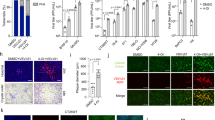Abstract
Purpose
Immunosuppression is one of hallmark features in many cancers including glioma. Triptolide, a natural compound purified from the Chinese herb Tripterygium wilfordii, has been reported to inhibit PD-L1 otherwise known as the B7 homolog 1 (B7-H1) expression in breast cancer. The purpose of this paper is to test the effects of Triptolide on T cell inhibition in glioma cells.
Methods
We labeled T cells and cocultured with Interferon-γ (IFN-γ) and Triptolide treated glioma cells. The effect on inhibition of T cells as well as subtypes of T cells was measured by Flow Cytometry. We also tested the expression of PD-L1 in six glioma cell lines.
Results
We found that Triptolide could reverse T cell inhibition especially CD4+ T cell and induced IFN-γ secretion. In addition, Triptolide could also induce interleukin-2 secretion and overcome interleukin-10 inhibition caused by glioma cells under IFN-γ treated condition. Triptolide could also down-regulate IFN-γ induced PD-L1 surface expression in glioma cells.
Conclusions
These results suggest that Triptolide may be used to reverse CD4+ T cell inhibition caused by glioma cells and is an alternative candidate for targeting PD-L1, one of the checkpoint inhibitors for the treatment of glioma.







Similar content being viewed by others
References
Johnson DR, O'Neill BP (2012) Glioblastoma survival in the United States before and during the temozolomide era. J Neurooncol 107(2):359–364.
Parsa AT, Waldron JS, Panner A et al (2007) Loss of tumor suppressor PTEN function increases B7-H1 expression and immunoresistance in glioma. Nat Med 13(1):84–88
Xue S, Song G, Yu J (2017) The prognostic significance of PD-L1 expression in patients with glioma: a meta-analysis. Sci Rep 7(1):4231
Dong H, Strome SE, Salomao DR et al (2002) Tumor-associated B7-H1 promotes T-cell apoptosis: a potential mechanism of immune evasion. Nat Med 8(8):793–800
Berghoff AS, Preusser M (2016) In search of a target: PD-1 and PD-L1 profiling across glioma types. Neuro Oncol 18(10):1331–1332
Wang Z, Zhang C, Liu X et al (2016) Molecular and clinical characterization of PD-L1 expression at transcriptional level via 976 samples of brain glioma. Oncoimmunology 5(11):e1196310
Hirano F, Kaneko K, Tamura H et al (2005) Blockade of B7-H1 and PD-1 by monoclonal antibodies potentiates cancer therapeutic immunity. Cancer Res 65(3):1089–1096
Curiel TJ, Wei S, Dong H et al (2003) Blockade of B7-H1 improves myeloid dendritic cell-mediated antitumor immunity. Nat Med 9(5):562–567
Brahmer JR, Tykodi SS, Chow LQ et al (2012) Safety and activity of anti-PD-L1 antibody in patients with advanced cancer. N Engl J Med 366(26):2455–2465
Pulko V, Harris KJ, Liu X et al (2011) B7-H1 expressed by activated CD8 T cells is essential for their survival. J Immunol 187(11):5606–5614
Yang S, Chen J, Guo Z et al (2003) Triptolide inhibits the growth and metastasis of solid tumors. Mol Cancer Ther 2(1):65–72
Liang M, Fu J (2008) Triptolide inhibits interferon-gamma-induced programmed death-1-ligand 1 surface expression in breast cancer cells. Cancer Lett 270(2):337–341
Dietz AB, Bulur PA, Emery RL et al (2006) A novel source of viable peripheral blood mononuclear cells from leukoreduction system chambers. Transfusion 46(12):2083–2089
Zhang H, Zhu W, Su X et al (2012) Triptolide inhibits proliferation and invasion of malignant glioma cells. J Neurooncol 109(1):53–62
Sai K, Li WY, Chen YS et al (2014) Triptolide synergistically enhances temozolomide-induced apoptosis and potentiates inhibition of NF-kappaB signaling in glioma initiating cells. Am J Chin Med 42(2):485–503
Flies DB, Han X, Higuchi T et al (2014) Coinhibitory receptor PD-1H preferentially suppresses CD4(+) T cell-mediated immunity. J Clin Invest 124(5):1966–1975
Mangani D, Weller M, Roth P (2017) The network of immunosuppressive pathways in glioblastoma. Biochem Pharmacol 130:1–9
Nduom EK, Weller M, Heimberger AB (2015) Immunosuppressive mechanisms in glioblastoma. Neuro Oncol 17(Suppl 7):9–14
Wintterle S, Schreiner B, Mitsdoerffer M et al (2003) Expression of the B7-related molecule B7-H1 by glioma cells: a potential mechanism of immune paralysis. Cancer Res 63(21):7462–7467
Yao Y, Tao R, Wang X, Wang Y, Mao Y, Zhou LF (2009) B7-H1 is correlated with malignancy-grade gliomas but is not expressed exclusively on tumor stem-like cells. Neuro Oncol 11(6):757–766
Zhang L, Zhang Z, Liu Y, Xue Y, Parney I (2015) Programmed death-ligand 1 (PD-L1) may play a role in malignant glioma infiltration. Med Hypotheses 85(2):127–129
Trickett A, Kwan YL (2003) T cell stimulation and expansion using anti-CD3/CD28 beads. J Immunol Methods 275(1–2):251–255
Pene J, Rahmoun M, Temmerman S, Yssel H (2003) Use of anti-CD3/CD28 mAb coupled magnetic beads permitting subsequent phenotypic analysis of activated human T cells by indirect immunofluorescence. J Immunol Methods 283(1–2):59–66
Funding
This study was funded by FasterCures, a center of the Milken Institute and the National Institutes of Health (NS048959).
Author information
Authors and Affiliations
Corresponding author
Ethics declarations
Conflict of interest
The authors declare that they have no conflict of interest.
Research involving human participants and animals
No animals or humans were involved in this study.
Additional information
Publisher's Note
Springer Nature remains neutral with regard to jurisdictional claims in published maps and institutional affiliations.
Rights and permissions
About this article
Cite this article
Zhang, L., Yu, J.S. Triptolide reverses helper T cell inhibition and down-regulates IFN-γ induced PD-L1 expression in glioma cell lines. J Neurooncol 143, 429–436 (2019). https://doi.org/10.1007/s11060-019-03193-0
Received:
Accepted:
Published:
Issue Date:
DOI: https://doi.org/10.1007/s11060-019-03193-0




